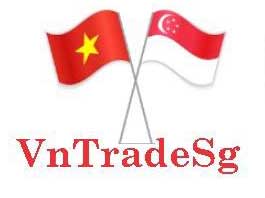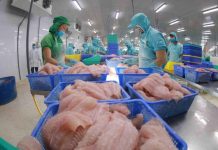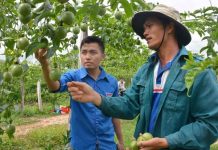I. Overview of textile and garment production, consumption and manufacturing technology in Vietnam
1. Production and Consumption
Enterprises have actively sought other sources of supply for inputs production, they are willing to import materials from China again when the epidemic is under control and the supply is sourced from China.
Regarding the outputs, the pandemic is spreading again in the EU and the US, so some enterprises in these markets have suspended orders with Vietnamese partners. Some enterprises reflect that the time for opening an LC takes longer, 120 days while before was 60 days. The more enterprises use the FOB method, the more difficulties they are facing due to dead capitals in raw materials.
*Production: Textile production index and apparel production index in March 2020 increased by 7.7% and 6.5% over the previous month, respectively, grew by 2.1% and decreased by 4.1% in the same period in 2019. Some products in the industry have witnessed a growth namely: Woven fabrics from natural fibers were estimated to reach 53.4 million m2, an increase by 1.9% over the previous month, and by 18.5 % when compared with the same period last year; fabric production from synthetic and artificial fibers was estimated to reach 91.2 million m2, up by 15.6% over the previous month, down by 16.2% over the same period last year; casual clothes were estimated to reach 356.7 million pieces, up by 4.4% over the previous month, down by 5.7% when compared to the same period last year.
By the end of the first 3 months of 2020, fabrics made from natural fibers were estimated to reach 148.2 million m2, an increase by 11.3%; compared to the same period; production of synthetic and artificial fibers is estimated to reach 246.9 million m2, down by 9.6% over the same period last year; casual clothes were estimated to reach 1,046.2 million pieces, down by 3.1% over the same period last year.
* Consumption: In the month, the most consumed items were suits, uniforms, jackets, pants, overalls, non-knitted or crocheted shorts for adults, down by 3,60%; the 2nd largest products is synthetic filament fiber, up by 1.7%; Twine from natural fibers: cotton, jute, flax, coir, rush, increased by 5.90% ..
In addition, according to the USDA report, supply exceeds demand when China, the world’s leading cotton consumer, has more than half of its plants operating at only 50-75% of theirs capacity due to the impact of the COVID-19 epidemic. Global consumption is forecasted to decline to 5.39 million bales.
Table 1: Production of some textile and apparel products in March 2020
| Items | Unit of measurement | Mar 2020 | Compared to FebSo 2020 (%) | Compared to Mar 2019 (%) | 3 months in 2020 | Compared to 3 months in 2019 (%) |
| Fabric from natural fibers | Million m2 | 53,4 | 1,9 | 18,5 | 148,2 | 11,3 |
| Fabric from synthetic or hand-made fibers | Million m2 | 91,2 | 15,6 | -16,2 | 246,9 | -9,6 |
| Regular clothes | Million pcs | 356,7 | 4,4 | -5,7 | 1046,2 | -3,1 |
Source: General Statistics Office
Table 2: Production of some textile and apparel products in March 2020
| Tên sản phẩm | Unit of measurement | Mar 2020 | Compared to FebSo 2020 (%) | Compared to Mar 2019 (%) | 3 months in 2020 | Compared to 3 months in 2019 (%) |
| Suit, uniform, jacket, pant, overalls, non-woven or knitted short for adults | 1000 pcs | Total | 182.510 | 7,35 | -2,71 | 520.985 |
| Synthetic filament yarn | Ton | Total | 128.546 | 3,44 | 3,00 | 360.488 |
| Fiber from natural yarns: cotton, jute, flax , coir, papyrus | Ton | Total | 81.330 | 12,31 | 8,53 | 214.632 |
| Suits, uniforms, jacket, pants, allovers, non-woven or knitted shorts for adults | 1000 pcs | Total | 60.716 | 1,43 | -12,94 | 187.204 |
| Fabric woven from filament fiber | 1000 m2 | Total | 61.378 | 11,62 | -13,17 | 170.157 |
| Non-woven or knitted underwears for adults | 1000 pcs | Total | 43.257 | 1,83 | -4,87 | 122.825 |
| Non-woven or knitted shirts for adults | 1000 pcs | Total | 44.486 | 23,50 | -12,11 | 116.980 |
| Sacks and bags for packing from other woven fibers | 1000 pcs | Total | 35.962 | -0,29 | -0,59 | 105.333 |
| Woven fabric from cotton fiber with up to 85% cotton | 1000 m2 | Total | 36.943 | 2,05 | 25,38 | 100.726 |
| Woven fabric from synthetic filament fiber | 1000 m2 | Total | 31.641 | 24,48 | -21,53 | 81.533 |
| Fabric from polyester staple fiber with less than 85% cotton | Ton | Total | 18.128 | 11,12 | 9,92 | 50.488 |
| Non-woven or knitted underwears for adults | 1000 pcs | Total | 12.825 | 35,40 | -14,03 | 33.695 |
| Facial, bath and other kitchen and toilet towels | 1000 pcs | Total | 9.850 | -16,73 | 47,62 | 27.664 |
| Other woven fabrics from cotton fiber | 1000 m2 | Total | 9.024 | 3,84 | 7,53 | 25.769 |
| Tulle mosquitoe net | Ton | Total | 7.058 | 2,25 | -11,58 | 21.120 |
| All types of blanket, duvets, mattress, cushions, chair cushions, pillows, sleeping bags and other similar types with springs or filling with plastic or rubber of flexible foam materials | 1000 pcs | Total | 1.975 | -0,01 | 23,09 | 5.784 |
: Preliminary statistics from General Statistics Office và other Statistics Offices
Table 3: Consumption of some textile and apparel products in February 2020
| Products | Unit of measurement | Feb 2020 | Compared to Jan 2020 (%) | Compared to Feb 2019 (%) | 02 months in 2020 | Compared to two first months of 2019 (%) |
| Suit, uniform, jacket, pant, overalls, non-woven or knitted short for adults | 1000 pcs | 166.601 | -3,60 | 17,79 | 339.426 | 2,02 |
| Synthetic filament yarn | Ton | 126.405 | 1,17 | 44,68 | 251.345 | 29,36 |
| Fiber from natural yarns: cotton, jute, flax , coir, papyrus | Ton | 64.913 | 5,90 | 36,32 | 126.209 | 14,57 |
| Fabric woven from filament fiber | 1000 m2 | 63.186 | 21,35 | 28,74 | 115.255 | 14,43 |
| Non-woven or knitted underwears for adults | 1000 pcs | 40.385 | 1,37 | 13,27 | 80.226 | 1,49 |
| Sacks and bags for packing from other woven fibers | 1000 pcs | 38.524 | 17,24 | -2,93 | 71.385 | -19,13 |
| Non-woven or knitted shirts for adults | 1000 pcs | 34.758 | 4,63 | 18,99 | 67.979 | -1,56 |
| with up to 85% cotton | 1000 m2 | 33.980 | 22,41 | 31,53 | 61.738 | 9,04 |
| Woven fabric from synthetic filament fiber | 1000 m2 | 21.050 | 21,61 | -14,44 | 38.359 | -31,17 |
| Fabric from polyester staple fiber with less than 85% cotton | Ton | 15.176 | -3,55 | 35,04 | 30.912 | 22,21 |
| Non-woven or knitted underwears for adults | 1000 pcs | 11.339 | 19,79 | 3,19 | 20.804 | -26,53 |
| Other woven fabrics from cotton fiber | 1000 m2 | 8.513 | 7,54 | 14,12 | 16.429 | 4,76 |
| Tulle mosquitoe net | 1000 pcs | 10.383 | 75,32 | 28,29 | 16.306 | 18,53 |
| Facial, bath, other kitchen and toilet towels | Ton | 6.403 | -20,68 | -0,12 | 14.475 | -8,57 |
(Source: General Statistics Office)
2. Textile and garment manufacturing techonoly
* Copper nanoparticles being tested for anti-virus textiles
Pioneering UK manufacturer, Promethean Particles, reports it is collaborating with textile companies and leading research facilities to explore the anti-viral effects of its novel copper nanoparticles designed for use in fabrics and Personal Protective Equipment (PPE) for the healthcare sector.
At Promethean, we have traditionally developed nano-copper for the printed electronics market, due to the conductive properties of copper. Copper is also well known for its antimicrobial properties and during the past few years we have researched this further in the funded Innovate UK project, ACTIn.
Promethean Particles has experience in developing copper nanoparticles for electronics because copper is also one of the materials with antibacterial properties and currently Promethean Particles is looking to take that a step further to consider the potential effect copper could have on viruses. If we can show evidence of anti-viral properties from the testing currently being carried out, then it’s particularly relevant to the current Covid-19 outbreak, and we may see a lot more urgency in its development
Promethean Particles played a key role in the ACTIn project, funded by the Newton Fund, which saw Mexican and UK companies and research institutes successfully develop durable antimicrobial textiles for the healthcare sector. By embedding nano-copper into polymer fibres, such as nylon, via a melt extrusion process, it was found that the antimicrobial effect lasted longer than other similar antimicrobial fabrics on the market, which tended to be surface-coated.
Now, in conjunction with the Mexican research institute, CIQA and the textile trade association, NWTexNet, strands embedded with copper nanoparticles manufactured by Promethean scientists have been sent to laboratories in the United States. and UK for anti-virus testing with ISO standards. If certified, it could open up opportunities for the production and supply of nonwoven and Personal Protective Equipment (PPE), such as clothing, masks, hats, uniforms and bed sheets, capable of antiviral – like the coronavirus that causes Covid-19 and will improve the supply of antibacterial materials for frontline health care workers.
By using nano-copper, as opposed to larger copper particles, a smaller mass of active material is required to achieve the same antimicrobial effect bringing both cost and process benefits to the manufacturer.
Prior to the Covid-19 pandemic, this research was a strategically important focus area for both the UK and Mexico due to the significant economic and social impact of healthcare-acquired infections that lead to extended patient stays in hospitals.
Promethean said there was potential to further develop its nano-copper materials for use in coating applications for door handles, handrails and beds within the healthcare sector.
The company, a developer of high specification nano-materials for a wide range of sectors, is also in talks with a manufacturer to develop a transparent antimicrobial coating containing its nano-copper technology suitable for glass. Ideal for incorporating into a range of touchscreen personal devices, as well as those found at train stations, cinemas, and fast-food restaurants, the coatings would inhibit the growth of bacteria and mold on surfaces. By using nano-copper particles, glass transparency is retained. For most applications, having both antimicrobial and anti-viral functionality will be of huge benefit to manufacturers.
3. Opportunities for cooperation, investment and technology transfer with CPTPP member countries
*Domestic enterprises need to pay more attention to CPTPP to create opportunities
After the Comprehensive and Progressive Agreement for Trans-Pacific Partnership (CPTPP) has entered in force for more than 1 year, trade import and export turnover between Vietnam has seen positive progress. In terms of Vietnam’s export turnover to CPTPP member countries, the growth rate increased compared to the same period last year (but export to Australia decreased by 11.4% due to the impact from the sharp reduction of crude oil exports to this market).
Exports mainly focus on items that Vietnam has strengths such as electronic components, textiles, footwear, machinery, and equipment… Some markets that do not have FTA relations with Vietnam like Canada, Mexico recorded a sharp increase after the Agreement came into effect. Specifically: exports to Canada grew up to 29.9%, significant growth of machinery, equipment, and other spare parts, up by 136.1%; while telephone components increased by 82.1%… Most of products exported to Mexico increased, namely telephone components soared by 518.1%; machinery, equipments and other spare parts grew up by 65.2%. Although Japan does not have an FTA with Vietnam, exports to this market increased by 8.4%, of which plastic materials grew sharply by 170.3%, iron and steel increased by 69.2% …
Regarding the provinces that have import and export reports, 27 out of 63 provinces have extra import and export activities with CPTPP countries, including the top Ho Chi Minh City, followed by Ha Noi, Ba Ria Vung Tau, Bac Ninh and Khanh Hoa. Export products from localities to CPTPP countries are quite diverse from agriculture, fisheries, handicrafts, textiles to machinery, electronic components … In addition, exports of some provinces to CPTPP countries are quite high, such as Hanoi (20.8%) and Da Nang (nearly 40%).
Although the CPTPP offers impressive opportunities, it is known that many provinces in the provinces and cities have little interest in exporting to CPTPP countries and very few join the export activities. Regarding the opportunities for export growth as well as investment cooperation under the CPTPP Agreement to develop Vietnam’s exports to access the Canadian market, it is also necessary to look into market research, identification of HS code, consequently know the import tariff rates, documents proving the origin of goods as well as identifying means of transport.
II. Textile and garment export and import between Vietnam and CPTPP members
1. Export
1.1. Overview of export to CPTPP member countries
Most of markets currently restrict the entry of people, not for the goods. Yet but measures of epidemic control will affect the speed of goods movement from export, transportation, clearance, storage … and will disrupt the consumption. Therefore, regulations related to epidemic control in this area will also trouble Vietnamese enterprises to sign export orders with their partners, thus trade and investment promotion activities between the two sides will also be affected.
If the COVID-19 epidemic continues complicated developments in the second quarter of 2020, textile enterprises will be more strongly affected at the stage of output product management. The textile and garment industry is facing difficulties because both domestic and international markets are reducing their consumption. Many enterprises are seeking ways to reduce costs and take into account labor resources until the end of the epidemic.
According to preliminary statistics from the General Department of Customs, textile and garment export turnover in March 2020 reached over 2.33 billion USD, up by 4.68% compared to February 2019 but decreased by 7.70% compared to March 2019. By the end of the first 3 months of 2020, the export turnover of this commodity reached 7.03 billion USD, a decline of 1.31% compared to the same period in 2019.
Exports to some countries in the CPTPP group reached US $ 463.1 million, accounting for 19.8% of the proportion, a rise of 21.4% compared to February 2020, and a fall of 7.9% compared to the same period of the previous year. Thus, in the first 3 months of this year, Vietnam’s textile and garment exports to some CPTPP countries reached the US $ 1.2 billion, an increase of 2.1% over the same period last year.
In March 2020, export turnover of textile and apparel to Japan took the lead, followed by Canada and Australia.
Table 4: Vietnam’s Textile and garment export turnover to some CPTPP members in March and the first three months in 2020
| Market | Mar 2020 (USD) | Compared to Feb 2020 (%) | Compared to Mar 2019 (%) | 3 months in 2020 (USD) | Compared to 3 months in 2019 (%) | Tỷ trọng T3/2020 với CPTPP(%) | Tỷ trọng KN T3/2020 với cả nước (%) |
| Total | 2.338.580.908 | 4,7 | -7,7 | 7.032.619.604 | -1,3 | 100,0 | |
| Including CPTPPgroup | 463.123.112 | 21,4 | 7,9 | 1.236.060.986 | 2,1 | 100,0 | 19,8 |
| Japan | 349.517.897 | 25,2 | 9,1 | 914.030.277 | 1,8 | 75,5 | 14,9 |
| Canada | 54.998.860 | 12,4 | 7,7 | 155.288.836 | 6,2 | 11,9 | 2,4 |
| Australia | 23.682.028 | 16,1 | 7,4 | 62.636.910 | 3,3 | 5,1 | 1,0 |
| Chile | 10.293.493 | 49,0 | 18,6 | 27.080.047 | -13,9 | 2,2 | 0,4 |
| Malaysia | 9.706.619 | -5,6 | 4,4 | 28.272.246 | 15,3 | 2,1 | 0,4 |
| Singapore | 6.455.234 | 23,2 | -12,3 | 19.324.962 | -5,3 | 1,4 | 0,3 |
| Mexico | 6.215.196 | -15,0 | -20,0 | 22.481.880 | -1,0 | 1,3 | 0,3 |
| New Zealand | 2.253.785 | -29,4 | -14,5 | 6.945.828 | 2,9 | 0,5 | 0,1 |
(Source: Preliminary statistical data of the General Department of Vietnam Customs.)
Figure 1: Developmnent of Vietnam export turnovers to CPTPP member countries
during the period 2018 – 2020 (unit: million USD)
(Source: Preliminary statistical data of the General Department of Vietnam Customs.)
1.2. Export with CPTPP members
1.2.1. Textile and Garment export to Japan
Japan is one of the major markets of Vietnam and is currently expanding their imports of many of our products. Textiles are items with many advantages, in terms of quality, price as well as long-lasting partnerships between manufacturers and importers. Therefore, domestic enterprises need to create their own brand values with good design and quality.
Exports to Japan require strict standards for products, complex distribution systems, high costs of trade promotion, thus in order to accomplish effectiveness in negotiation and save costs, enterprises need to be well-prepared. With the development of advanced technical technologies, a large proportion of experienced and professional workforce and preferential policies of the State, the textile industry has gained a lot of encouraging results, creating values of goods for people to utilize while ensuring the demand of domestic consumption and exports to other countries in the world market.
In March 2020, Vietnam’s textile and garment exports to Japan reached US$ 349.5 million, accounting for 14.9% of the national share and accounting for up to 75.5% of the CPTPP group, an increase by 25.2% compared to the previous month and by 9.1% compared to March 2019. For the first 3 months of the year, exports to this market reached US $ 914.0 million, a rise of 1.8% over the same period last year.
Table 2: Export turnover of Vietnam’s textile to Japan
(Unit: Million USD)
Source: Preliminary statistics from the General Department of Customs
1.2.2 . Textile and Garment export to Canada
Although CPTPP has no US market (the market accounts for nearly 50% of Vietnam’s annual textile and apparel export turnover), there are still many potential markets such as Australia, New Zealand, Chile, especially the Canadian market. .
Mặc dù CPTPP không có thị trường Mỹ (thị trường chiếm gần 50% kim ngạch xuất khẩu dệt may hàng năm của Vietnam), nhưng còn nhiều thị trường có tiềm năng lớn như Australia, New Zealand, Chile, đặc biệt thị trường Canada.
Canada is a very potential market in Vietnam with the import turnover of textiles and apparel worth about 13.3 billion USD / year. However, Vietnam’s textile and garment exports to Canada are still modest, reaching the US $ 666.7 million in 2018, and the trend of US $ 815.1 million in 2019. Currently, Vietnam has not signed a free trade agreement (FTA) with Canada, so the CPTPP will help open up opportunities for Vietnam to accelerate the development of the textile and garment sector in this market in the coming years.
Canada là thị trường rất tiềm năng của Vietnam với kim ngạch nhập khẩu hàng dệt may khoảng 13,3 tỷ USD/năm. Tuy nhiên, xuất khẩu dệt may của Vietnam sang Canada còn khá khiêm tốn, năm 2018 đạt 666,7 triệu USD, năm 2019 có xu hướng tăng lên đạt 815,1 triệu USD. Hiện Vietnam chưa ký Hiệp định thương mại tự do (FTA) với Canada, do đó CPTPP sẽ giúp mở ra cơ hội để Vietnam tăng tốc độ phát triển lĩnh vực dệt may tại thị trường này trong những năm tới.
Vietnam’s textile and garment exports to Canada in March 2020 reached US $ 54.9 million, accounting for 2.4% of the country’s share and accounting for 11.9% of the CPTPP, up 12.4% and 7, 7% compared to the same period last year. Thus, in the first 3 months, exports of this product to Canada reached US $ 155.2 million, up 6.2% over the same period last year.
Figure 3: Vietnam’s Export turnover in textile and garment to Canada
during 2018 – 2020 (unit: million USD)
(Source: Preliminary statistics from General Department of Customs
1.2.3. Textile and Garment export to Australia
Australia is committed to eliminate 93% tariff lines, equivalent to 95.8% Vietnam’s export turnover (worth 2.9 billion USD) as soon as the CPTPP agreement enters into force. According to a roadmap, tariff lines for the other products will be erased at maximum at the last period. Textile products are among potential exported products to Australia. Australia imported textile per year is worth over 9 billion USD while the market share for Vietnam’s imported textile accounting for 1.9% total import turnover of textile, equivalent to approximately 200 million USD. However, Vietnam will face competition with China as the imported textile share from China accounts for 60% if Vietnam textile wants to enter the Australia market.
Vietnam’s textile and garment export to Australia in March 2020 reached US $ 23.6 million, accounting for only 1.0% of the country’s share and 5.1% of the CPTPP, up 16.1%. compared to the previous month and up 7.4% over the same month last year. For the first 3 months of this year, exports of this item to Australia reached 62.6 million USD, up 3.3% over the same period in 2019.
Figure 4: Vietnam’s export turnover of textile and garments to Australia in the period from 2018 to 2020 (Unit: Million USD)
(Source: Preliminary statistics from General Department of Customs
2. Import
2.1. Overview of import to CPTPP members
Even in the first months of 2020, textile enterprises spent the first two months of the year facing a shortage of raw materials and supplies when China suppliers up to 80% of raw materials had to close their borders to stamp out. turn off the disease.
By March, when Chinese manufacturers had restored about 80% of their supply of raw materials, then in the second phase of the outbreak in the US and Europe, the two main markets accounted for more than 60% of total turnover. Export of textile products of Vietnam.
According to statistics of the General Department of Customs, the total import turnover of textile and garment materials in March 2020 reached US $ 540.1 million, up 46.2% compared to February 2019 and 2.9% compared to February. with March 2019. Generally, in 3 months, import turnover of this commodity in Vietnam still decreased over the same period, reaching 1.2 billion USD, down 3.9%.
In particular, the market share of CPTPP block reached 25.6 million, accounting for only 4.7% of the proportion and both decreased compared to the previous month and compared to the same period last year with an increase of 7.6% and 16 respectively. , 3%. Generally, in the first 3 months of the year, imports of textile and apparel NPL from this market reached US $ 71.5 million, down 10.2% over the same period last year. Japan leads the way among Vietnam’s CPTPP textile import markets; followed by, Malaysia, Australia …
Table 8: Vietnam’s import turnover in materials and accessories for textile and garment from CPTPP members in March and in the first 3 months in 2020
| Market | Mar 2020 (USD) | Compared to Feb 2020 (%) | Compared to Mar 2019 (%) | 3 months in 2020 (USD) | Compared to 3 months in 2019 (%) | Proportion of Mar 2020 in CPTPP(%) | Proportion of Mar 2020 in the whole country (%) |
| Total | 540.158.582 | 46,2 | 2,9 | 1.276.789.400 | -3,9 | 100,0 | |
| Including CPTPP group | 25.606.878 | -7,6 | -16,3 | 71.598.723 | -10,2 | 100,0 | 4,7 |
| Japan | 21.446.525 | -9,3 | -7,7 | 58.842.267 | -9,1 | 83,8 | 4,0 |
| Malaysia | 1.810.973 | -0,1 | -30,0 | 4.858.475 | -30,4 | 7,1 | 0,3 |
| Australia | 1.619.629 | -0,9 | -12,3 | 4.411.661 | 9,8 | 6,3 | 0,3 |
| New Zealand | 426.356 | 14,5 | 123,8 | 919.900 | 17,1 | 1,7 | 0,1 |
| Canada | 185.171 | 72,8 | -93,0 | 421.760 | -85,5 | 0,7 | 0,0 |
| Singapore | 118.224 | -8,4 | 43,3 | 2.144.660 | 665,7 | 0,5 | 0,0 |
(Source: Preliminary statistics from General Department of Customs
Figure 5: Vietnam’s import turnover in textile and garment materials from CPTPP members in the period from 2018 to 2020 (Unit: million USD)
(Source: Preliminary statistics from General Department of Customs)
2.2 Import from CPTPP members
2.2.1. Imported materials and accessories for the textile and garment industry from Japan
Vietnam imports materials and accessories for textiles mainly from China, Korea, ASEAN, and the EU … Imports from Japan account for only 3.8% of the country’s total import turnover and account for 85,4% in the CPTPP group. In March 2020, import turnover from this market reached US $ 21.4 million, decreased compared to the previous month and compared to the same period in 2019, with a decline of 9.3% and 7.7%, respectively. Thus, , imports of this item from Japan in the first 3 months reached US $ 58.8 million, a fall of 9.1% over the same period in 2019.
Figure 6: Vietnam import turnover in textile and garment from Japan in the period from 2018 to 2020 (Unit: Million USD)
(Source: Preliminary statistics from General Department of Customs
2.2.2. Imported materials and accessories for the textile and garment industry from Malaysia
CPTPP countries commit to eliminating from 97% to 100% of import tax lines for goods originating from Vietnam and the commitments of each country vary. Tariffs for most of Vietnam’s exports to other CPTPP countries will be fully eliminated when the Agreement comes into effect or according to roadmaps.
Malaysia pledged to eliminate 84.7% of tariff lines as soon as the Agreement came into effect and gradually eliminate the remaining tariff lines with roadmaps. In the 11th year, the number of tariff lines committed by Malaysia to cut down is 99.9%.
According to the statistics of the General Department of Customs, imported materials and accessories for textile and garment industry from Malaysia in March 2020reached US $ 1.8 million, accounting for 0.3% of the country’s total import turnover and accounting for 7.1% of the CPTPP group, a decline of 0.1% compared to the previous month and a drop of 30.0% over the same period in 2019. Total imports of these items from Malaysia in the first 3 months of this year reached US $ 4.8 million, a drop of 30.4% compared to the same period of 2019.
Figure 8: Vietnam import turnover in textile and garment from Malaysia in the period from 2018 to 2020 (Unit: Million USD)
(Source: Preliminary statistics from General Department of Customs )
III. Policies related to cooperation of manufacturing, investment, technology, trade of Vietnam’s textile and apparel with CPTPP countries
* Regulations on import and export enterprises in CPTPP
The CPTPP Agreement sets out regulations in most areas, of which trade in goods is the area that is remarkably affected by CPTPP. With preferential policies and even strict requirements, import and export activities of enterprises are considerably influenced by the CPTPP.
As a typical example, the leather and footwear industry has a high growth rate in some CPTPP countries such as Australia, Canada, and Singapore while the protection of this industry in those countries is still quite high. The difference between ordinary preferential tax (MFN) and the preferential tax rate in the CPTPP is quite large. Once the CPTPP comes into effect, the footwear industry will not only benefit from tariff reductions, but protection barriers to from other countries will also be removed. Even Canada, a country that has never had a bilateral FTA with Vietnam, pledged to eliminate 78 tariff lines for Vietnam’s exported footwear products to 0% as soon as this Agreement comes into effect.
Similarly, the textile industry also has a great opportunity to increase its market share in CPTPP countries, with a predicted growth rate from 8.3 to 11%. Food and seafood processing industries with the advantages of origin also have many opportunities to penetrate new markets as well as to expand traditional export markets in the CPTPP when difficult markets like Japan have also committed to eliminating many tariff lines as soon as the CPTPP takes effect.
Vietnam has had regular trade relations with some countries such as Singapore, Japan … When CPTPP comes into effect, the rate of import and export of goods also increase. Import and export has been boosted but some disputes occur, mostly in the sectors that account for a large proportion such as agricultural products, timber, textiles… Therefore, in order to conclude safe international business contracts, enterprises need to take into account the risk identification and classification to avoid loss and damages.
4 out of 11 CPTPP countries have large import and export turnovers with Vietnam, namely Australia, Japan, Singapore, and Malaysia. Particularly, Singapore takes lead in the number of disputes related to foreign trade contracts with 91 cases, followed by Japan with 22 cases. Although there is no statistics on disputes of other countries in the CPTPP, disputes arising in international business are very common.
Vietnam has been integrating more deeply with a series of signed FTAs, which has brought significant benefits to import and export activities. However, the signing and execution of business contracts are not always favorable, but always face the risk of arising disputes. Even disputes can occur even with close partners, friends. Therefore, the management of business contracts is the most important, particularly to enterprises that sign many contracts with a wide range of partners.
It is time for enterprises to change the way of doing international trade including drafting contracts. In fact, most Vietnamese enterprises are small and medium-sized enterprises, so they do not ask lawyers for drafting contracts. Most of the contracts are drafted during the negotiation process, thus only content of the contract is discussed, not giving any information about applicable law until a dispute occurs. This is a loophole that may create disadvantages for enterprises when disputes arise. Besides, the provisions on arbitration are not clear, thus when disputes arise, parties do not know which agency to file for a sue and the fight on authority will be costly in terms of time and expenses. This will also make it difficult for enterprises to ask the court for assistance …
IV. Annex
Table 1: Some typical companies importing textile and garment products from CPTPP markets in March 2020
| STT | Company |
| 1 | Brotex (Vietnam) Co. Limited |
| 2 | Texhong Nhon Trach JSC |
| 3 | Texhong Ngan Long Technology Co. Limited |
| 4 | Texhong Ngan Ha Technology Co. Limited |
| 5 | Teijin Frontier Vietnam Co. Limited |
| 6 | Hyosung Dong Nai Co. Limited |
| 7 | Hung Nghiep Formosa Co. Limited |
| 8 | Hyosung Vietnam Co. Limited |
| 9 | Tainan (Vietnam). Spinning Co. Limited |
| 10 | Mtv Industrial Huafu (Vietnam) Co. Limited |
| 11 | Ha Nam Textiles Co. Limited |
| 12 | Xindadong Textiles (Vietnam) Co. Limited |
| 13 | Mei Sheng Textiles Vietnam Co. Limited |
| 14 | Kang Na Vietnam Co. Limited |
| 15 | Phong Phu Coats Co. Limited |
| 16 | Tainan Textile Co. Limited |
| 17 | Đông Khánh Textiles JSC |
| 18 | Ilshin Vietnam Co. Limited |
| 19 | Thien Nam Investment and Development JSC |
| 20 | New Century Polyester Fiber Vietnam Co. Limited |
| 21 | Haosheng Vina Co. Limited |
| 22 | Kyungbang Vietnam Co. Limited |
| 23 | Century Synthetic Fiber JSC |
| 24 | Ha Hae Vietnam Co. Limited |
| 25 | Lu Thai (Vietnam) Co. Limited |
| 26 | Dong-Il Vietnam Co. Limited |
| 27 | Yulun Spinning, Weaving and Dyeing (Vietnam) Co. Limited |
| 28 | Duc Quan Investment and Development JSC |
| 29 | Kuk Il Vietnam Co. Limited |
| 30 | Sunrise Textile (Vietnam) JSC |
| 31 | Dong Quang Textile JSC |
| 32 | Hualon Corporation Vietnam Co. Limited |
| 33 | Tongkook Vietnam Spinning Co. Limited |
| 34 | Hue Textile JSC |
| 35 | Mekong Spinning Co. Limited |
| 36 | Hoa Tho Textile JSC |
| 37 | Co. Limited Shengyang ( Vietnam) Textile Co. Limited |
| 38 | Tra Ly Spinning JSC |
| 39 | Vikohasan JSC |
| 40 | Phu Thanh Spinning JSC |
| 41 | Damsan JSC |
| 42 | Sewang Vina Co. Limited |
| 43 | Phu Bai Spinning JSC |
| 44 | Phu Nam Spinning JSC |
| 45 | Co. Limited Hợp Thành Co. Limited |
| 46 | Ky Nghe Evergreen Viet Nam Co. Limited |
| 47 | Nam Dinh Textiles JSC |
| 48 | Quyet Tien Service Trading Co. Limited |
| 49 | Hoang Thi Loan Textile JSC |
| 50 | Co Tah Tong Textile Vietnam Co. Limited |

















